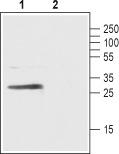Ffar1 Rabbit Polyclonal Antibody
Other products for "Ffar1"
Specifications
| Product Data | |
| Applications | WB |
| Recommended Dilution | WB: 1:200-1:2000 |
| Reactivities | Rat |
| Host | Rabbit |
| Clonality | Polyclonal |
| Immunogen | Peptide, (C)NVASFINPDLEGSWRK corresponding to amino acid residues 244-259 of rat free fatty acid receptor 1. |
| Formulation | Lyophilized. Concentration before lyophilization ~0.8mg/ml (lot dependent, please refer to CoA along with shipment for actual concentration). Buffer before lyophilization: Phosphate buffered saline (PBS), pH 7.4, 1% BSA, 0.05% NaN3. |
| Purification | Affinity purified on immobilized antigen. |
| Conjugation | Unconjugated |
| Storage | Store at -20°C as received. |
| Stability | Stable for 12 months from date of receipt. |
| Gene Name | free fatty acid receptor 1 |
| Database Link | |
| Background | Free fatty acids (FFAs) were for long believed to influence cellular metabolism. Hoever, the discovery that FFAs actually mediate their effects through one of three G-protein coupled receptors (GPCRs) - Free Fatty Acid Receptors 1-3 (FFAR1-3), has initiated a number of studies in order to assess their implication in health and disease. Like all other GPCRs, FFAR1-3 have seven transmembrane domains, an extracellular N-terminal tail and an intracellular C-terminus. FFAR1 is activated by either medium or long, saturated or unsaturated fatty acids, whereas FFAR2 and FFAR3 are activated by short chain fatty acids. FFAR1 is coupled to Gq and leads to Ca2+ mobilization upon activation. FFAR2 couples to both pertussis-sensitive and insensitive G-proteins and also leads to increased intracellular Ca2+ levels. FFAR3 coupling to G-protein induces an increase in cAMP. Distribution studies of all three FFA Receptors indicate that FFAR1 mRNA is quite elevated in the pancreas. FFAR1 is also detected in the liver, heart, skeletal muscle, and brain; although this broad localization pattern is supported only by one study. FFAR2 is expressed in many tissues like liver and colon. FFAR3 is expressed in many tissues but shows highest expression in adipose tissue. Relatively high expression of the receptor could be detected in pancreas, spleen, lymph nodes and bone marrow. As mentioned above, the finding that FFAsâ?? actions are mediated by GPCRs, prompted many studies in order to elucidate their roles in healthy and disease states. Such studies stipulate that FFAR1 may be involved in obesity and type 2 diabetes since circulating free fatty acid levels in the plasma are significantly elevated. On the other hand, FFAR2 and FFAR3 could be potential targets for treating irritable bowel disease and appetite control. |
| Synonyms | FFA1R; GPCR40; GPR40 |
| Reference Data | |
Documents
| Product Manuals |
| FAQs |
{0} Product Review(s)
0 Product Review(s)
Submit review
Be the first one to submit a review
Product Citations
*Delivery time may vary from web posted schedule. Occasional delays may occur due to unforeseen
complexities in the preparation of your product. International customers may expect an additional 1-2 weeks
in shipping.






























































































































































































































































 Germany
Germany
 Japan
Japan
 United Kingdom
United Kingdom
 China
China



